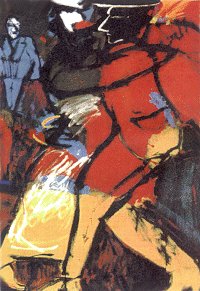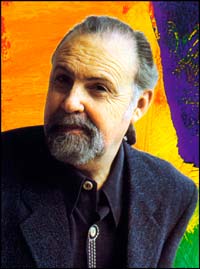By
Tango, a Black affair. Juan Carlos Cáceres, an Argentine in Paris

he great artist Juan Carlos Cáceres believes in the theory which considers tango to be of Black origin, and consequently regards candombe as the father of milonga, which would be, for her part, the mother of tango. He devotes his new CD to that belief, Tango negro, the fifth album he recorded since 1993, always in Paris. However, in the fourteen tracks of the record, several aspects of this flooding artist are displayed: compulsive creator, outstanding pianist, singer and composer who overflows with ideas and jumps from wild Latin American rhythms or beats from the River Plate to the intimate confession in a café on a rainy day.
 As music cannot contain him, Cáceres also paints (he is teacher in plastic arts) and with the launching of this CD, at the Galerie Monde de l'Art, in the Latin Quarter he opened an exhibition of forty pictures which unfurl the theory of the alleged African root of tango.
As music cannot contain him, Cáceres also paints (he is teacher in plastic arts) and with the launching of this CD, at the Galerie Monde de l'Art, in the Latin Quarter he opened an exhibition of forty pictures which unfurl the theory of the alleged African root of tango.
In some of the canvases he portrays, with his lively neo-figurative style, Black or mulatto soldiers who fought in the war against Paraguay and who later would reappear brandishing clarinets and bandoneons.
Cáceres studied plastic arts in Buenos Aires (where in past years he exhibited a series about Latin America history at Van Riel gallery), he took up the trombone, threw himself into jazz, and in the 60s he went to Spain from where he moved to France, precisely in May 1968. He is capable of telling us, better than anyone else, about the Argentine exile, as he did in his composition “Sudacas”, which, in turn, gave its name to another outstanding CD issued in 1995.
Cáceres always establishes a suggestive interplay of distance and sadness (blues). While he portrays Argentinians with the perspective of one who managed to go far away, he sings and says with the nuances of the neighborhood and the Buenos Aires local expressions of someone who, like Troilo, never left his home town.
 Between teasing and sentimental, with casual and not meticulous verse, witty and hoarse, he acknowledges being follower of Edmundo Rivero and Roberto Goyeneche, recalling love failures and yesterdays when everything was possible, Cáceres lets thin threads of philosophy flutter above his songs to surrender himself to some frenzied rhythm or a deep tango beat in the next track of each CD.
Between teasing and sentimental, with casual and not meticulous verse, witty and hoarse, he acknowledges being follower of Edmundo Rivero and Roberto Goyeneche, recalling love failures and yesterdays when everything was possible, Cáceres lets thin threads of philosophy flutter above his songs to surrender himself to some frenzied rhythm or a deep tango beat in the next track of each CD.
With that palette he appeared successfully from Istanbul to Quebec, but as it had to be, he is a perfect stranger in Argentina. As in the noteworthy previous CD —Juan Carlos Cáceres íntimo— in Tango negro there is also a recovery of somewhat classic pieces, such as “Malevaje”, “Como dos extraños”, “Serafín” and “Vuelvo al sur”. The rest is of his own tenacious and, at times, hasty creation.
Two musicians of the level of the bandoneon player César Stroscio and the pianist and arranger Juan Carlos Carrasco contribute to this contagious celebration of the roots honored from uprootedness.
Extracted from the magazine Tres puntos, May 1999.